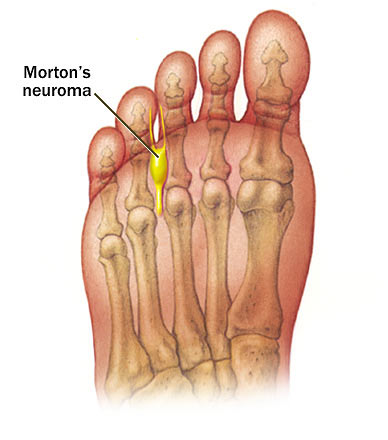Pain, numbness or tingling in the forefoot, usually between and extending into the third and fourth toes, almost always indicates a neuroma. A neuroma often hurts more when you’re wearing shoes and feels better when you take them off and massage the feet. Neuromas slowly become more painful with time if left untreated.
Causes

A neuroma is caused by pinching or irritation of one or more nerves in the forefoot. This is usually the result of poor biomechanics and/or over-pronation. If you over-pronate, the metatarsal bones can have excessive movement which in turn can cause irritation, by a tight ligament, to the nerve which runs between the metatarsal heads. The result of this direct irritation is inflammation and pain. If a neuroma is left untreated the nerve can become chronically scarred, creating even more pain.
Treatment
You can try using a metatarsal pad under the affected area. This should reduce some of the excessive motion of the metatarsals and hopefully reduce the pain. Exact placement of the pad is important. Custom orthotics are often used to control the over-pronation. They often incorporate a specialized metatarsal pad within them and can usually provide more relief. If this doesn’t work a podiatrist should be consulted to assess the degree of nerve damage. An injection may be warranted. Another good option is a minimally invasive nerve decompression procedure. This is a simple in-office procedure, which provides very effective, long-term relief of the chronic pain from neuromas. As a last resort, open surgery might be indicated to remove the damaged nerve. This will solve the problem, but will lead to permanent numbness between two toes.
Prevention
Since over-pronation is very often the culprit, switching to running shoes with more motion control should be helpful.
Activity Restrictions
None really, but it is best to wait until the pain subsides or is treated before engaging in long runs or lengthy activities.